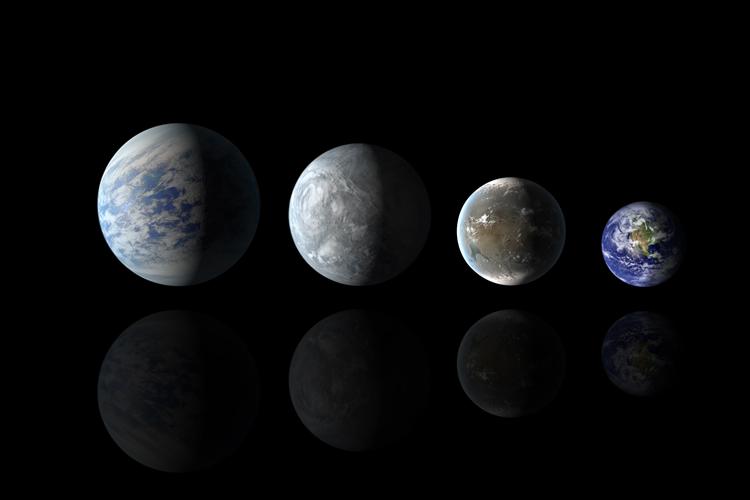Life on Other Planets
[untitled photo of compared planets].Retrieved April 10, 2014, from:http://dailyfreepress.com/2013/04/29/kepler-mission-finds-three-potentially-life-sustaining-planets/
Many people have asked about life on other planets and whether or not the possibility of another earth actually exists. Well, this question is closer to being answered than ever before! NASA has made the discovery of earth-like planets that have the potential of hosting life.
In 2009, a probe (Kepler) was launched into space and given the mission “to determine how common or rare planets like our own are in the galaxy,” according to NASA scientist Thomas Barclay. (3) In February 2014, the probe came back with data supporting the theory that our galaxy could contain billions of planets that are similar to Earth. This is a massive discovery that has changed the view of outer space from a massive void to a large portion of uncharted territory.
![[untitled photo of satellite].Retrieved April 1-, 2014, from:http://en.wikipedia.org/wiki/Kepler_(spacecraft)](https://thejetstreamjournal.com/wp-content/uploads/2014/04/220px-Keplerpacecraft.019e.jpg)
Kepler was able to find billions of planets that are similar to Earth, but most of the planets are too far away to be properly analyzed and studied. Many of the planets that Kepler has discovered are classified as Earth-like, meaning that the planet has similar temperatures to Earth and orbit a parent star similar to our sun.
No matter what, a planet, in order to be habitable, has to be located in what is called the habitable zone. This zone is to ensure temperatures are livable in that area. Technology has advanced enough for us to be able to detect water and temperatures of planets that are far away, but we have yet to develop the proper technology to determine what the air surrounding the planet contains.
April 18, 2013, NASA broadcasted their findings of three Earth-sized planets that could possibly sustain life. These planets were named Kepler-69c, Kepler-62f, and Kepler-62e. The Kepler planets are light-years away and are super-Earth sized (1.5 to 1.75 times bigger than Earth). K69c was found in the Cygnus constellation while K62f and K62e were found in the Lyra constellation. The planets circle stars that are smaller than the sun, and they rotate faster and closer too. Because of their different movement, the orbits of the planets are much different than that of our own. K69c has an orbit of 242 days, K62e has an orbit of 122 days, and K62f has an orbit of 267 days. Kepler made this amazing discovery. To go even further, it also found another set of three planets that could host life.
The other three planets are located 22 light-years away and they are a part of a solar system of seven planets. These seven planets orbit a star named Gliese 667C. Gliese is part of a three-star system called Gliese 667 and is located in the Scorpius constellation. The planets that were found are, like the other Kepler planets, classified as super-Earths, and are thought to be either rocky and dry or completely covered with water. Also, these planets are similar to the moon because they are tidally locked. Being tidally locked means that there is one side of the planet that is always facing the star, while the other side of the planet is always shadowed.
![[untitled photo of possibly hospitable planets].Retrieved April 10, 2014, from:http://phl.upr.edu/press-releases/fivepotentialhabitableexoplanetsnow](https://thejetstreamjournal.com/wp-content/uploads/2014/04/HEC_Confirmed_Gliese581g-300x150.jpg)
These discoveries have inspired people to write books and movies about what is out in space. Shows like Cosmos: A Space Time Odyssey have been created to explain theories about outer space. The TV show puts these scientific theories into terms that the general population can understand and they are able to give a more graphic image to the public because of the wonders of television.
The human race has come very far in unraveling the mysteries of the universe, but we still have a long way to go before finding life on another planet.
Works Cited
“Earth-Like Planet Can Sustain Life.” DNews. N.p., n.d. Web. 11 Apr. 2014.
Jha, Alok. “Two Billion Planets in Our Galaxy May Be Suitable for Life.” Theguardian.com. Guardian News and Media, 04 Nov. 2013. Web. 09 Apr. 2014.
“Kepler Mission Finds Three Potentially Life-sustaining Planets.” The Daily Free Press. N.p., n.d. Web. 11 Apr. 2014.
Landau, Elizabeth. “Researchers: Newly Found Planets Might Support Life.” CNN. Cable News Network, 01 Jan. 1970. Web. 11 Apr. 2014.














Phelan Castellano • Apr 15, 2014 at 11:16 am
Great story! Very intriguing!!
Maddy J • Apr 15, 2014 at 11:11 am
I’m a fan of “Keplar” myself.